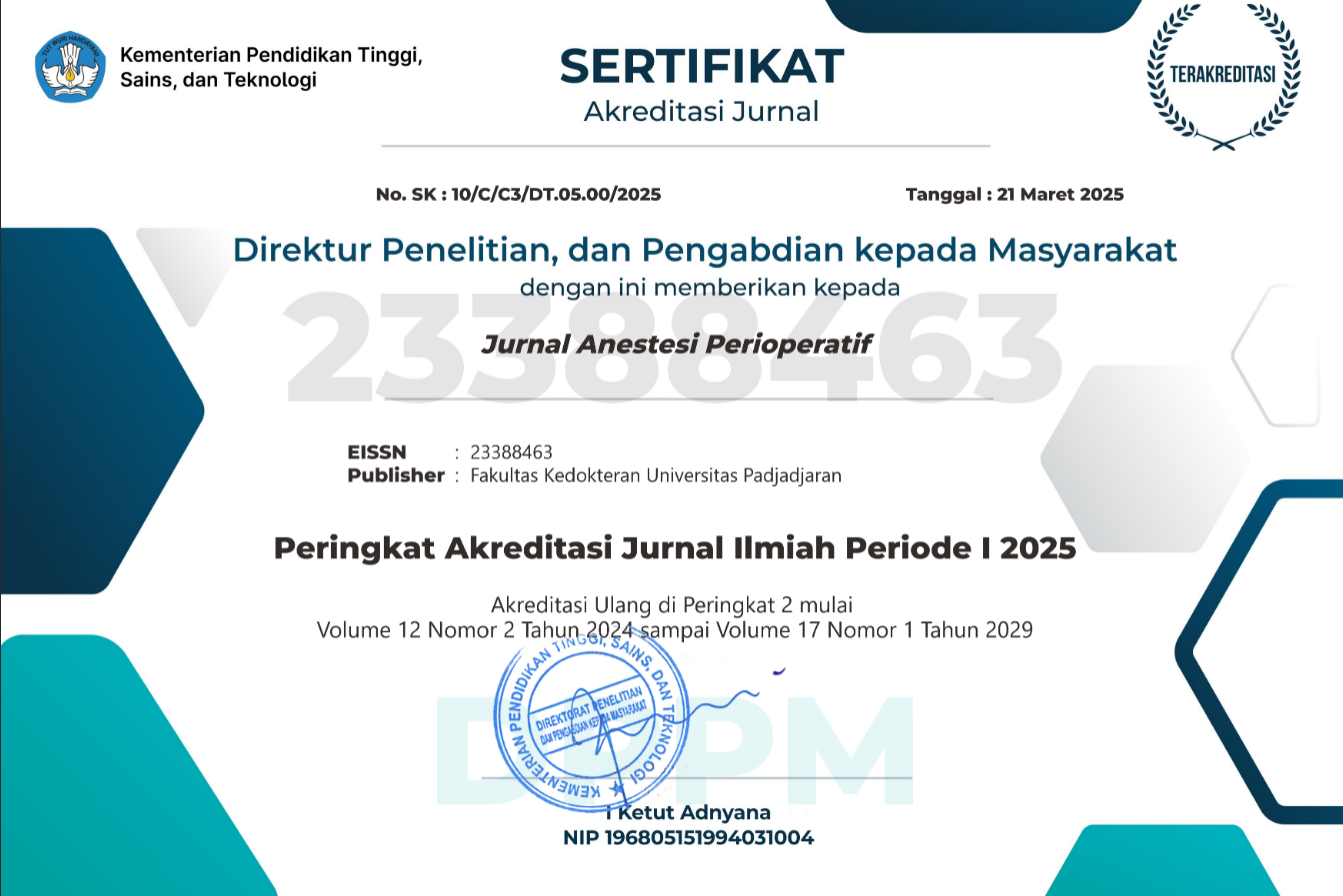Anesthesia Management of Oculocardiac Reflex in Strabismus Surgery: A Case Study
Abstract
There are various types of eye surgery with each requires special attention in anesthesia management. Strabismus surgery has several risks that need to be considered; one of which is oculocardiac reflex. The oculocardiac reflex is a condition characterized by decreased heart rate caused by the pressure on the globe or by traction on the extraocular muscles and conjunctiva or the orbital structures. This reflex can manifest as an asystole if left untreated. This is a case report of a 19-year-old male with ASA classification 1 presented with esotropia of left and right eyes. General anesthesia was used for anesthesia with 100 mcg fentanyl, 100 mg propofol, and 25 mg atracurium for induction and, for airway management, LMA size 3 was used. Sevoflurane 2–3 vol% with oxygen and nitrous oxide was given as maintenance. During the surgery, the heart rate dropped to 35 beats per minute when the operator pulled the medial rectus muscle in the first eye. The surgery was then paused and the heart rate was incrementally increased to 65 beats per minute without any other intervention. Then, as the operator pulled the medial rectus muscle in the second eye, the heart rate decreased to 55 beats per minute and the surgery continued with the heart rate slowly increased without any intervention. The remaining surgery time was uneventful. Knowledge and early intervention of oculocardiac reflex conditions should be well understood by all anesthesiologist to avoid more catastrophic conditions.
Manajemen Anestesi untuk Reflek Okulokardiak pada Operasi Strabismus: Laporan Kasus
Terdapat banyak jenis operasi pada mata, setiap operasi membutuhkan penanganan anestesi yang khusus. Operasi strabismus memiliki beberapa risiko yang perlu menjadi perhatian, salah satunya adalah refleks okulokardiak. Refleks okulokardiak merupakan konisi yang ditandai dengan penurunan denyut jantung disebabkan oleh tekanan pada bola mata atau penarikan pada otot-otot ekstraokular pada konjungtiva atau strukur orbita. Tanpa penanganan refleks ini dapat menyebabkan asistol. Sebuah laporan kasus mengenai laki-laki 19 tahun dengan klasifikasi ASA 1, dengan esotropi pada kedua mata yang akan dilaksanakan operasi strabismus. Anestesi umum dilaksanakan dengan obat-obat induksi fentanil 100 mcg, propofol 100 mg, dan atrakurium 25 mg, LMA ukuran 3 digunakan untuk managemen jalan napas. Sevofluran 2–3% dengan oxygen dan nitrous oxide digunakan untuk rumatan. Sewaktu operasi denyut nadi menurun sampai 35 kali per menit ketika operator menarik otot medial rektus pada mata pertama, kemudian operasi diminta dihentikan sementara, kemudian denyut nadi meningkat perlahan kembali ke 65 kali per menit tanpa pemberian intervensi lain. Kemudian, ketika operatot menarik otot medial rektus pada mata kedua denyut jantung menurun ke 55 kali per menit, operasi dilanjutkan dan denyut jantung meningkat tanpa intervensi lain. Operasi berlangsung tanpa kejadian lain. Pengetahuan dan penanganan awal kondisi refleks okulokardiak perlu diketahui oleh dokter anestesi untuk mencegah kondisi yang lebih berbahaya.
Keywords
Full Text:
PDFReferences
McGoldrick KE, Gayer SI. Anesthesia for ophthalmologic surgery. In: Barash PG, Cullen BF, Stoelting RK, Cahalan MK, Stock MC, Ortega R, editors. Barash clinical anesthesia. 8th ed. Philadelphia: Wolters Kluwer; 2017. p. 3433–93.
Butterworth JF. Mackey DC. Wasnick JD. Morgan & Mikhail’s clinical anesthesiology. 5th Edition. New York: McGraw-Hill Education; 2013. p. 759–68.
Davies IDM, Sale SM. Anaesthesia for paediatric eye surgery. Anaesth Intens Care Med. 2017;18(1):37–40.
Ahmed D. Updates in pediatric ophthalmic anesthesia. Anaesthesia, Pain Intens Care. 2014;18(1):72–9.
Bharati SJ, Chowdhury T, editor. The oculocardiac reflex. Trigeminocardiac Reflex. 2015. p. 89–99.
Jean YK, Kam D, Gayer S, Palte HD, Stein ALS. Regional anesthesia for pediatric ophthalmic surgery: a review of the literature. Anesth Analg. 2020;130(5):1351–63.
Gayer S. Ophthalmic surgery. In: Allman KG, Wilson IH, O’Donnell AM, editors. Oxford handbook of anaesthesia. 4th ed. United Kingdom: Oxford University Press; 2016. p. 661–81.
James I. Anaesthesia for paediatric eye surgery. Contin Educ Anaesthesia, Crit Care Pain. 2008;8(1):5–10.
Callaway NF, Moshfeghi DM, Jaffe RA. Ophthalmic surgery. In: Jaffe RA, Schmiesing CA, editors. Anesthesiologist’s manual of surgical procedures. 5th ed. California: Wolters Kluwer; 2014.
Kumar C, Dodds C, Gaye S, editors. Ophthalmic anaesthesia (Oxford Specialist handbooks in anaesthesia). United Kingdom: Oxford University Press; 2012.
Arasho B, Sandu N, Spiriev T, Prabhakar H, Schaller B. Management of the trigeminocardiac reflex: facts and own experience. J Neurol India. 2009; 57(4):375–80.
DOI: https://doi.org/10.15851/jap.v9n1.2388
Article Metrics
Abstract view : 2474 timesPDF - 1044 times
This Journal indexed by

JAP is licensed under a Creative Commons Attribution-NonCommercial 4.0 International License
View My Stats



